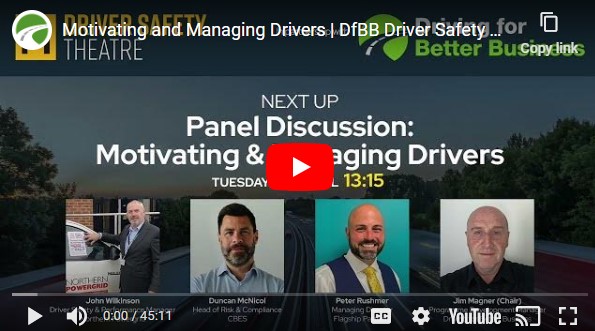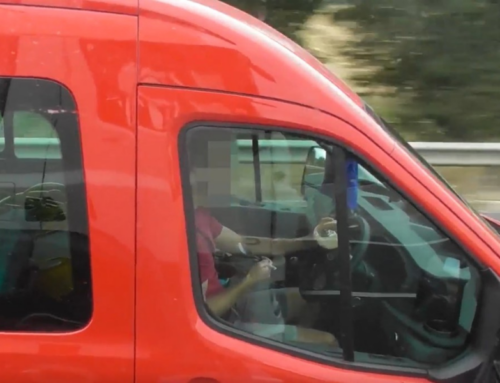An expert panel at the Health and Safety Event 2024 discussed managing driver behaviour – and it all starts with a robust driving for work policy.
Driving for Better Business launched its Driving for Work Policy Builder, a comprehensive, interactive tool for creating and reviewing a robust policy for work-related driving in the session immediately prior to this discussion.
Chaired by Jim Magner from the Driving for Better Business team, the driver management panel, comprising John Wilkinson, Driver Safety and Performance Manager at Northern Powergrid, Pete Rushmer, MD at consultancy Flagship Partners and Duncan McNicol, Head of Risk and Compliance at construction company CBES, agreed a sound policy was an essential starting point for fleet safety.
Driver management – setting expectations
The panel agreed that a driving for workk policy is fundamental in setting expectations; establishing and fulfilling legal responsibilities; explaining to drivers and managers what is actually expected in terms of driver behaviour; and that it must be led from the top and the front for optimal compliance.
McNicol says a policy is a framework that sets out how you do things. It’s a platform and basis for your rules and processes.
They also agreed that policies must be living documents, changed as necessary, and reviewed regularly.
Rushmer emphasised the need for clear communication of the policy and what that means to drivers, not just at launch or driver induction but repeatedly.
A policy can establish the company’s high-level expectations, but drivers must then feedback how this works in practice so that the policy achieves its objectives while also being aligned to operational need. If this doesn’t happen drivers can be faced with a contradiction between what they are expected to do, and what they feel they must do to manage their workload.
Using front-line feedback can create the highest performance levels, the most robust policies and the highest level of employee engagement.
Rushmer described the performance trifecta of direction, skills and engagement in order to achieve organisational safety. He describes it as like fire, which needs oxygen, fuel and heat. Remove any one element and the fire will die.
Driver engagement – face to face
There is no substitute for face-to-face communication, says Wilkinson, so in a big organisation that means giving high levels of training and support to first-line managers who will provide that contact. Much messaging is done through apps, texts, emails and video, but managers must find opportunities for face-to-face conversations, especially with remote workers.
Drivers should also be told about their driving behaviour. Most people believe they are good drivers and so often do not recognise their behaviours as risky.
McNicol says his organisation, like many others, captures all kinds of metrics through telematics, and it is really important to distil and simplify this data so the key metrics can be passed directly to drivers.
Crucial tip: Communication isn’t just about what’s said but about what’s heard. Driver behaviour is the best guide as to whether messages are getting through.
Training requirements
HGV drivers must undergo mandatory training but can also benefit from regular assessment or feedback and training based on telematics.
However, many companies employing van drivers, who are looking to maintain high standards, use a ‘Permit to Drive’ scheme with desk-based assessments, intensive training and a pass or fail test, before allowing them behind the wheel on business.
Northern Powergrid found younger drivers were disproportionately represented in collision statistics, so it has amended its block training to instead give six half days interspersed with driving alongside a company-qualified driver. This is currently a pilot scheme but appears to be yielding good results.
Northern Powergrid also runs a five-year rolling programme of in-cab training to refresh skills and safety messages with an emphasis on low-speed manoeuvres, such as parking and reversing.
CBES uses elearning programmes, but is also analysing its collision risk to develop bespoke training programmes.
Rushmore says that FORS and DVSA’s Earned Recognition scheme, both of which the company audits for, want to move fleets away from the ideas that a licence qualification automatically implies competence to drive, or that ‘compliance’ equals safety.
Driver Motivation
People are motivated by many things, including recognition, salary, peer company and respect, ownership, autonomy and much more. Finding out what motivates specific drivers and using as many positive reinforcements of safe driving behaviour as possible helps to raise and maintain safety standards.
Conversely drivers need to know when a behaviour is unacceptable. The panel discussed the ‘no blame culture’. People must feel safe enough to be honest and report incidents, and the company can support drivers making honest mistakes. However, deliberate violation of policy must be challenged. If company culture encourages openness about mistakes, but supports drivers in doing better, then accountability, motivation and progress can co-exist.
Register for the DfBB Driving for Work Policy Builder here.
Driver Safety Zone 2024 – video presentations
Other presentations from the Health and Safety Event presentations can be viewed here.







